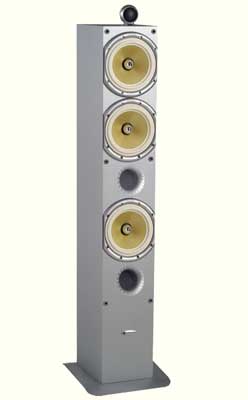Introduction
The THX logo, long familiar to moviegoers and
now commonplace on the faceplate of receivers, is still rarely seen on home
theater speakers. While several established manufacturers produce THX home
theater systems, Crystal Acoustics is the new kid on the block. Formed in
1998 by Greek engineer Visilis "Bill" Tsakiris, Crystal Acoustics is a
British-based OEM manufacturer of THX speakers.
Beginning in 2005, Crystal
began offering THX-certified home theater systems to the North American
market. With its own manufacturing factory in China, Crystal Acoustics
offers the THX3D-12 system at a price of $1,999; but as of press-time, the
THX3D-12 is available factory direct (in silver finish) for $1,799.
Can you
really turn your listening room into a THX theater for less than $2,000?
Let's find out.
The Design
The THX 3D-12 system consists of
floor-standing L/R speakers, a two-way center channel speaker, dipole
surround speakers, and a powered subwoofer with a 12-inch driver. The system
is
THX Select Certified.
The three
front speakers share the same drivers, a 1" neodymium tweeter mounted on top
of the speaker on a free-standing swiveling post, and 6.5-inch
fiberglass/Kevlar mid/woofers. In fact, the combination of the Crystal
Acoustics' yellow woofers with bullet-cone plugs, dimpled ports, and the
top-mounted tweeters, gave the speakers more than a passing resemblance to
my reference B & W speakers.
The THX-T3 speakers are 3 ½-way designs,
with three 6.5" woofers, the top-mounted tweeter, and two front ports. A rap
of the knuckles to the side of the THX T-3 front speakers produced a fairly
hollow "thunk" (evidence of minimal internal bracing), an obvious cost/benefit
choice given the system's overall price and performance.
The THX T-3s have
the narrow profile common to THX Certified speakers (ostensibly to enhance
wide horizontal dispersion). The THX-Center uses a single 6.5" woofer and
tweeter in the preferred vertical alignment, which avoids diffraction
effects for listeners sitting off to the side. The front speakers (T-3s and
Center) have two
sets of gold-plated binding posts for bi-wiring. Note that the front speakers
are all nominally rated at 4 ohms, so the THX 3D-12 system should only be
used with receivers that can handle a 4 ohm load.
 The
THX-Dipole uses the same woofer as the front speakers, along with two
1" silk dome tweeters wired out-of-phase on the side panels.
The
THX-Dipole uses the same woofer as the front speakers, along with two
1" silk dome tweeters wired out-of-phase on the side panels.
The
THX-12Sub uses a front-firing, 12" long-throw woofer, mated to an internal
200 watt amplifier. The back panel of the subwoofer contains a line-level
(but not speaker level) input, volume knob, phase, and a two-way toggle for
volume control (THX or variable-which allows you to adjust gain using the
subwoofer's volume knob). There are also two large ports on the rear of the
enclosure.
Set-up
I experimented with setting up the front L/R
speakers in a variety of orientations, the optimal placement appearing to be
with the cabinets slightly toed-in, but with the swivel-mounted tweeters
oriented straight ahead rather than matching the toed-in pitch of the
cabinets. The dipole surrounds were mounted on stands against the side walls,
above and behind the listening position (per THX recommendations), and the
THX-12Sub took up the usual position in the front corner of the listening
room.
After calibrating speaker levels using the
automatic set-up microphone of my Integra DTR 7.6 THX-Select receiver, the
crossovers were all set to 80 Hz (again per THX specs). The grilles were left
off of the front speakers during the review period (I could not detect any
obvious tonal differences with the speaker grilles on or off, but the SAF
preferred the grille-off look).
Click Here to Go to Part II.